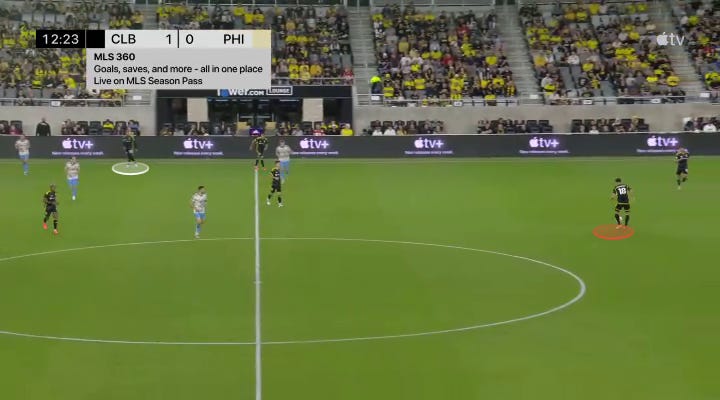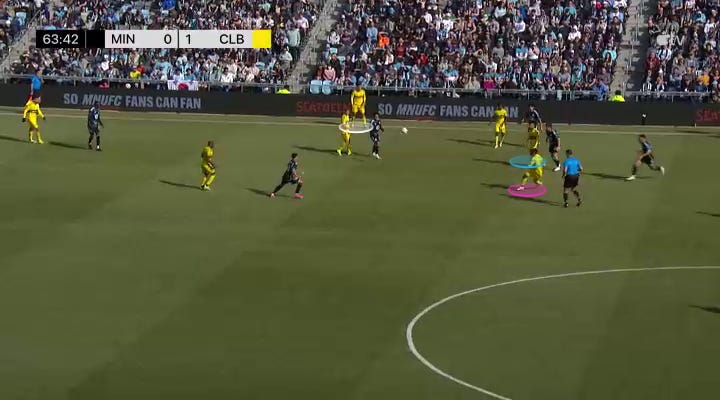Throw In Concepts Implemented By The Crew
These concepts were used by the Columbus side throughout the 2024 season
Throw ins are attracting more attention from clubs and teams.
After working with high level teams such as Liverpool, Thomas Gronnemark and his emphasis on throw ins have created more awareness for this set piece.
It’s not without merit. According to Statsbomb, there were about 35 throw ins per game in the 2023/24 Premier League season.
This post will look at some of the throw in concepts implemented by the Columbus Crew throughout the 2024 season:
Breaking a horizontal or vertical line directly from the throw in
The receiver of the throw in breaking a horizontal or vertical line
Creating space for the individual
Creating space for teammates
Breaking lines directly from the throw in
Before taking a look at how the Crew implemented this concept, a couple of terms need to be defined.
Vertical line breaking passes are common in the vocabulary of the football community. They are forward passes to teammates that break the line between opponents.
An example of a vertical line breaking pass can be seen below.
Horizontal line breaking passes are similar to vertical line breaking passes. Instead of a forward pass, they are lateral passes to teammates that break the line between opponents.
An example of a vertical line breaking pass can be seen below.
With an understanding of what horizontal and vertical line breaking passes are, a question that a throw in team (and especially the thrower) can ask themselves is if they can break a line directly from the throw in.
Late in the season against the Philadelphia Union, Mo Farsi, highlighted in white, was taking a throw in. He was able to break the Union’s horizontal line shown with the yellow connected dots.
The Crew’s left center back, highlighted in red, was able to receive with a lot of space to either progress with the ball or pick out a progressive pass.
In April when the Crew played the Portland Timbers, Steven Moreira, highlighted in white, was taking a throw in.
He was able to break the Timbers’ horizontal line highlighted in blue directly from the throw and find Cucho Hernandez who is highlighted in red.
Cucho was able to receive and break the Timbers’ vertical line highlighted in blue to try and find Diego Rossi who was making a run in behind.
The receiver of the throw in breaking a line
If an opposition’s line cannot be broken from the throw, the player receiving the throw in can look to execute that pass.
At the start of the season when the Crew played Minnesota United, Cucho, highlighted in red, dropped down from a higher position to receive a throw in.
He had already scanned and saw Minnesota’s backline, the space to be exploited behind and on the opposite side, and the positioning of his teammates.
Below, Cucho’s opposite sided teammate can be seen running onto the pass that broke Minnesota’s vertical line.
In the first leg of the CONCACAF Champions League, Yevhen Cheberko and Aiden Morris combined before finding a horizontal line breaking pass.
Below, Cheberko, highlighted in white, threw the ball into Morris who is highlighted in red. Morris played it back to Cheberko.
As the sequence developed, Cheberko was able to break Monterrey’s horizontal line highlighted in blue to find the opposite sided center back highlighted in red.
Creating space for the individual
Almost every team shifts towards the ball side and creates density for an opposition’s throw in. In order to be able to receive from a throw in, players have to create space for themselves.
In the same game against Philadelphia, Farsi, highlighted in white, was throwing the ball in. Diego Rossi, highlighted in red, checked towards the ball shown with the red dotted line.
This movement drug his mark with him. He would then exploit the space his mark vacated shown with the solid red arrow.
Below, Rossi highlighted in red, received the throw in after exploiting the vacated space.
Later in the same game, Cucho, highlighted in red, executed a double movement to create (and find) space shown with the red dotted arrows.
Creating space for teammates
This is high level concept that when implemented well, it can be hard to defend.
When the Crew played Inter Miami late in the season, Farsi, highlighted in white, was taking a throw in. Cucho and his mark can be seen with the red connected dots.
Rossi, highlighted in blue, was positioned higher and Alexandru Matan, also highlighted in blue, was supporting from a lower position.
Rossi and Matan, both highlighted in blue, converged their positioning which attracted the Inter Miami players in the area. This created more space between Cucho and his mark highlighted in red.
In the same game against Minnesota that was previously mentioned, Rossi, highlighted in blue, created space by moving towards the sideline which took his mark with him.
Cucho, highlighted in red, dropped down to receive the throw (which also broke a horizontal line) in the space that Rossi and his mark had vacated.
Conclusion
These are a just a few concepts that teams can look to incorporate into their own setups. The key is understanding the profiles of both the players and team at your disposal.
Luckily for the Crew, they have the personnel to implement high level individual and team actions from throw ins.
Photo: Marty Jean-Louis / Alamy Stock Photo

















